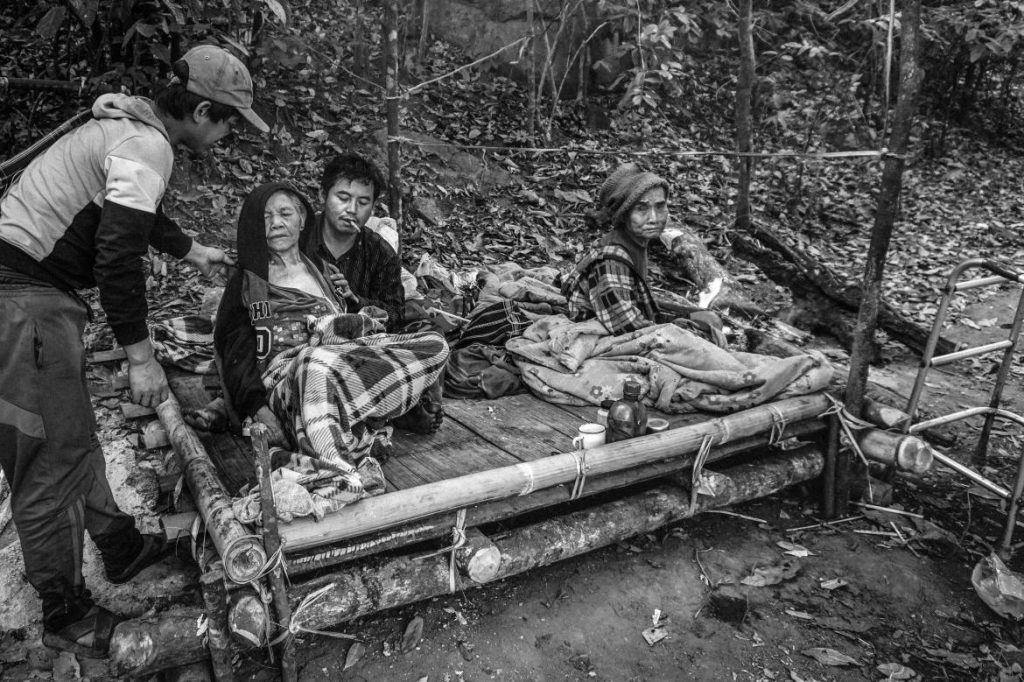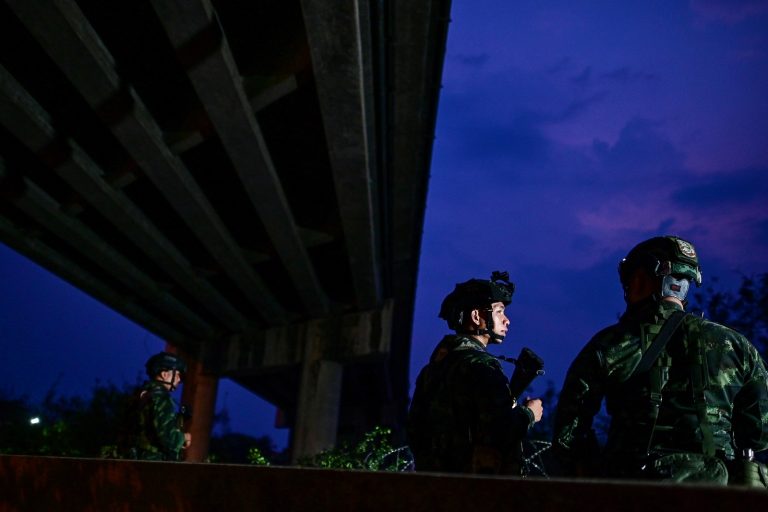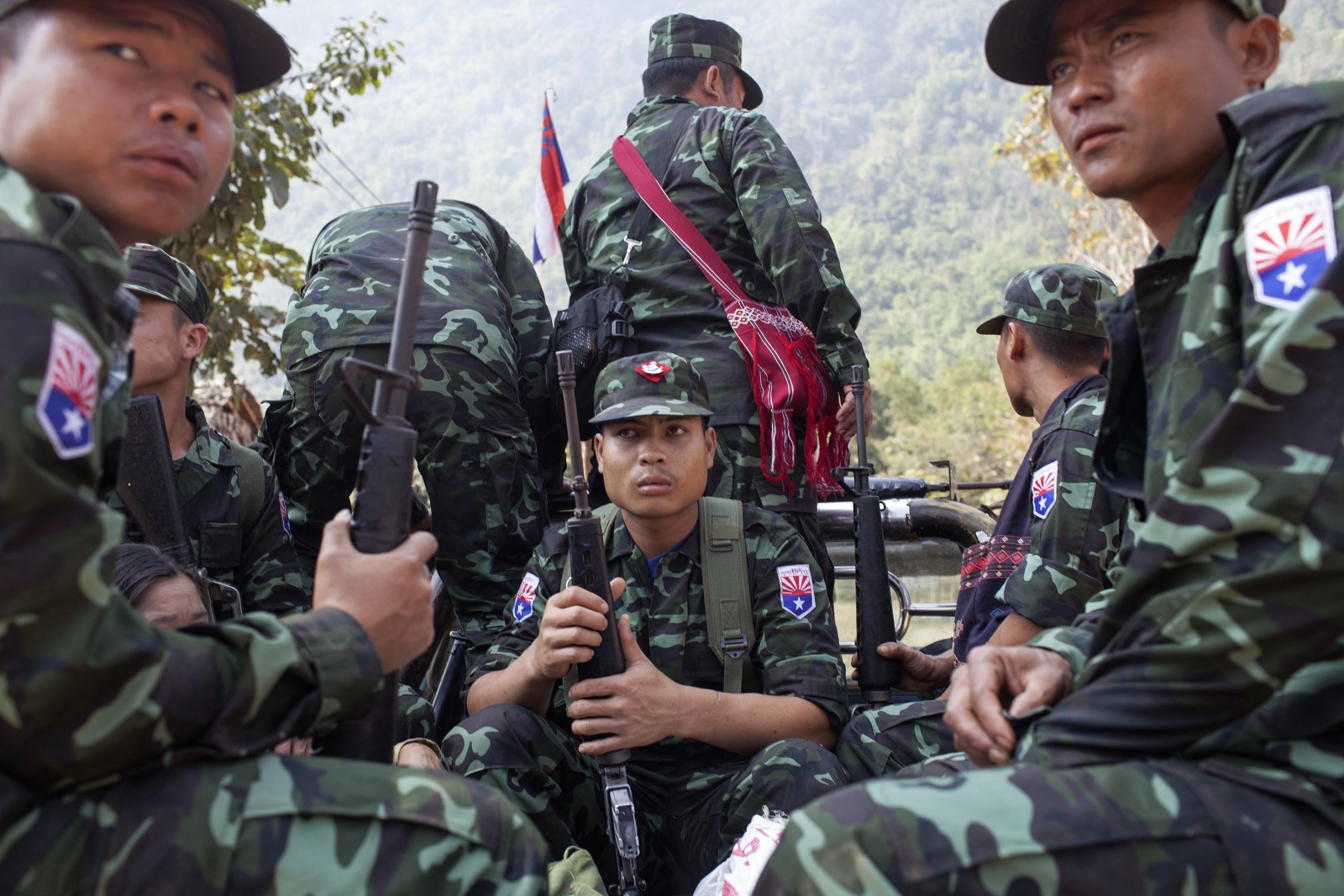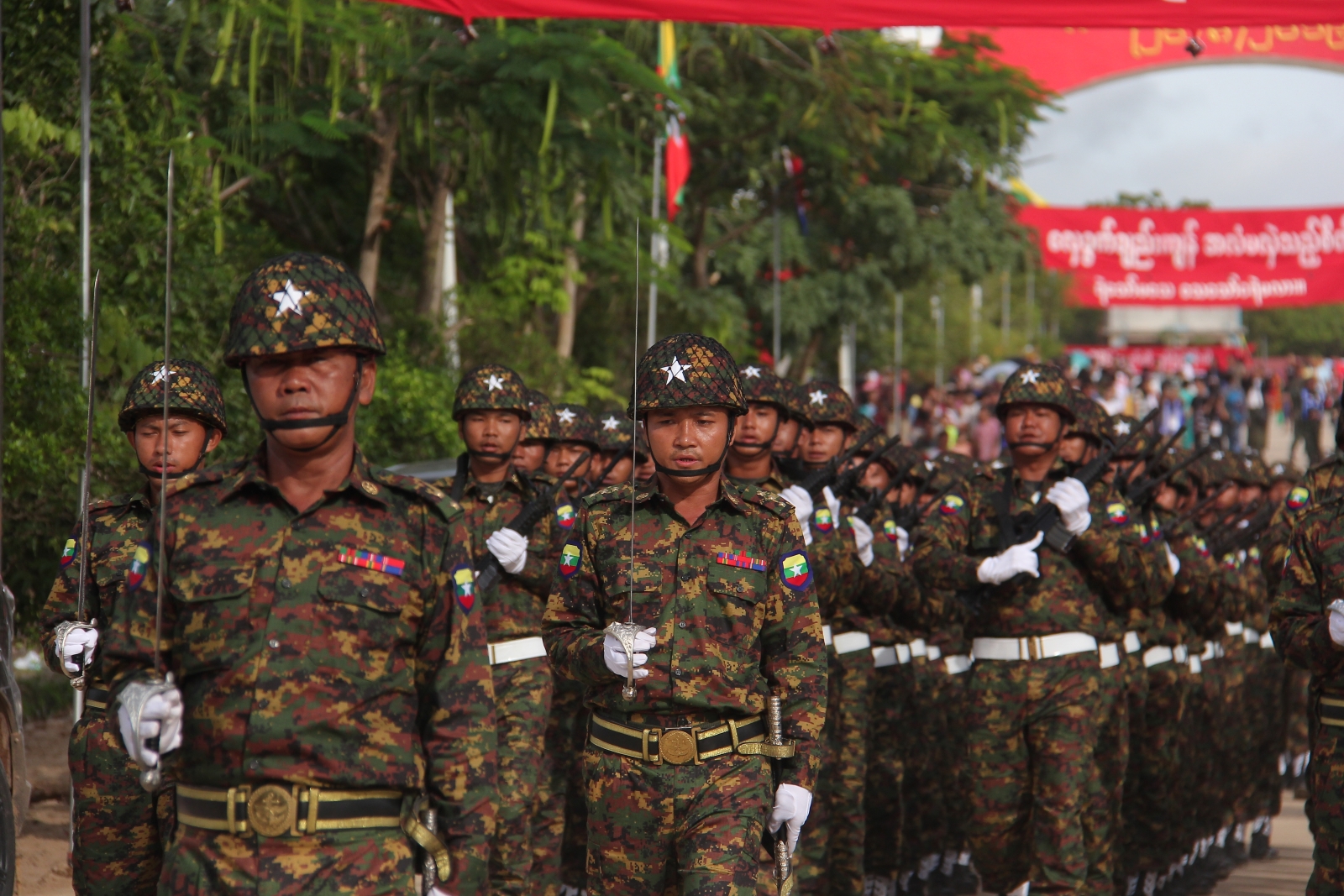Tatmadaw road-building in Kayin State has sparked clashes and mass displacement, threatening the ceasefire with the Karen National Union and dimming hopes ahead of the next Union Peace Conference.
By VINCENZO BEREZINI | FRONTIER
The eight-year-old ceasefire between the Tatmadaw and the Karen National Union came under renewed stress with armed clashes that peaked between February 2 and 15. During the flare-up, Myanmar artillery shelled Karen villages, displacing entire communities.
Accounts from displaced villagers, Karen civil society and the KNU suggest that civilians were deliberately targeted in order to clear the area around a strategic road network passing deep into KNU territory, but the Tatmadaw has denied this and claimed that army units were only responding to attacks from the Karen National Liberation Army, the KNU’s armed wing.
The Mutraw Community Development Committee says that as of February 23, 2,137 people, including 417 children aged under 5, had been displaced by the fighting in KNU-administered Mutraw District, which corresponds with Hpapun Township as demarcated by the Myanmar government. While several of the affected villages lie close to KNLA positions, villagers from many of the other settlements have said that there were no KNLA bases or soldiers nearby when the Tatmadaw fired mortar bombs at them, many of which fell directly into residential areas and close to schools.
These villagers, some of whom were interviewed by this author, said that the heightened Tatmadaw presence around the road upgrade, which began in early 2018, had been a constant source of fear, but that the latest artillery attacks on their villages had made them flee their homes.
Support independent journalism in Myanmar. Sign up to be a Frontier member.
Targeted and or indiscriminate shelling of civilian areas violates international humanitarian law and the terms of the Nationwide Ceasefire Agreement. The KNU, which has been in revolt against the central government since 1949, signed the NCA along with seven other ethnic armed groups in October 2015, after signing a bilateral ceasefire in 2012. Section 9 of the NCA prohibits the forcible displacement of civilian and says this is not limited to “ceasefire areas”.
Strategic goals
The KNU, which controls patches of territory along the Thai-Myanmar border but has a stronghold in Mutraw, reports that these strikes began on February 2 in areas abutting a network of roads being dug, repaired and widened since early 2018 by Tatmadaw engineers in Kayin State. The road network, much of which is currently unfit for large vehicles, connects the towns of Taungoo and Kyaukkyi, both at the foot of the Karen hills in Bago Region, to Tatmadaw camps in areas claimed by the KNU’s Brigade 5, including Saw Hta on the Thai border. Brigade 5 leaders fear these roads would also link to a long-planned road leading south to government-controlled Hpapun town. This road network, if upgraded, would significantly weaken the KNU’s control of the region.
The dilapidated north-south road from Kay Pu to Ler Mu Plaw, which crosses northern Mutraw’s Luthaw Township and joins a road linking Kay Pu with Taungoo to the north-west, was built during Tatmadaw offensives between 2005 and 2008. Earlier campaigns in the 1990s were also accompanied by road-building. Altogether, these Tatmadaw operations displaced about 80 percent of the inhabitants of Mutraw, according to the Committee for Internally Displaced Karen People, and involved widespread and well-documented abuses against civilians.
One possible trigger for the recent shelling of villages was an incident on January 27, when the Lieutenant Colonel Aung Kyaw Soe, commander of the Tatmadaw’s Light Infantry Battalion No 708, died in an explosion while attempting to disable a mine placed by the KNU along a road in Dwelo Township in southern Mutraw, close to the site of a later clash on February 23. In separate incidents, Tatmadaw soldiers have been injured and military vehicles damaged by KNU mines near Kyaukkyi. The KNU claims that these mines are strictly anti-vehicle devices, which allow pedestrians and horses to pass along the road unharmed, and denies the commander was targeted.
The KNU’s information department for Mutraw District claims the Tatmadaw fired mortar rounds into the Paw Khay Klo area, where the KNU has forbidden Tatmadaw cars from continuing eastwards on the road towards Saw Hta, as well as areas surrounding Tatmadaw positions in nearby Ler Mu Plaw and Kay Pu to the north. The Tatmadaw attempted to resume work on the Kay Pu-Ler Mu Plaw road in October last year but was repeatedly blocked by KNLA soldiers, who blew up construction equipment and defended positions near this road.
The KNU insists that the Tatmadaw road-building violates the NCA, which only allows pre-ceasefire military bases in contested areas to be maintained and re-supplied, and requires each side to secure permission before undertaking development work in territory claimed by the other.
Tatmadaw spokesperson Brigadier-General Zaw Min Tun has denied KNU allegations that the upgraded roads are intended to serve Tatmadaw military operations, rather than local development or the need to resupply existing bases, and that the Tatmadaw had intentionally targeted civilians in the recent shelling. “Our army shot artillery where there was a KNLA base only,” he told The Irrawaddy on February 11. “They ambush us to shoot our soldiers sometimes. They planted landmines to kill our soldiers. Therefore, we responded with our attack as we need to protect our soldiers for their security.”
On February 19, the KNU’s Central Command backed local KNU commanders’ prohibitions on Tatmadaw vehicles travelling along certain sections of the road network. Commanders from KNU Brigade 3 and 5 say during informal talks – most recently in Kyaukkyi on January 10 – local Tatmadaw commanders had agreed to only re-supply their bases on foot or by horse.
“The agreement between the Tatmadaw and KNU Brigades 3 and 5 is clear, as well as [at] central level,” said KNU Brigade 5 and Mutraw District spokesperson Major Saw Kler Doh. “Cars are permitted to travel between Muthe and Plakho [in KNU-administered Muthe and Luthaw townships respectively]. After this they must travel on foot or using horses.”
“To us the issue is simple,” he added. “Year by year they continue to attempt to construct the road [in the dry season], continually violating the terms of the NCA and disrespecting our agreements. This is why clashes continue to happen. Trust is based on both sides. Groups should respect the terms of the ceasefire.”

Karen National Liberation Army soldiers parade on Karen Revolution Day in Day Bu Noh. (Vincenzo Berezini | Frontier)
‘We stopped counting’
KNU Brigade 5 say that shelling peaked on February 3, when the Tatmadaw fired 40 mortar rounds at village clusters in Luthaw Township. The day before, KNU sources reported that Tatmadaw soldiers had shot and injured two villagers in Wah Thoe Kho village of Dwelo Township, following a skirmish between the KNLA and Tatmadaw in another area where the Tatmadaw is attempting to restart road construction.
According to the KNU and local villagers, the Tatmadaw then fired an average of six or seven mortar bombs daily between February 9 and 15. On several of these days, the author could hear the shelling from Dae Buh Noh, 35 kilometres away.
Interviews with displaced people confirmed KNU claims that at least 332 villagers belonging to 42 households from Plakho village tract fled to safety in Ler Mu Plaw village tract, both in Luthaw Township, on February 5 and 6 to escape artillery fire from the Tatmadaw’s Military Operations Command Battalion No 2. Displaced villagers said one of the shells narrowly missed a school in Kuday village of Plakho village tract. Most of the villagers have since returned but continue to report Tatmadaw firing near the village.
On February 15, Frontier visited a displaced family from Ku Day village who were camping in a nearby forest 10 days after their village was shelled. “Some of the villagers have gone back but we are still scared,” the young father said. “My mother is sick, and my father is over 80 years old and can hardly walk, and we have two young children.”
“The P’yaw Thu [a Karen term for Myanmar soldiers] want to pass along the road with their trucks; this is why we are being attacked,” he said. “Nobody from the village was injured, but one shell fell very close to us and luckily did not explode, unlike the others which fell just outside the village. We just wished they [the Tatmadaw] would stop attacking us so we can continue living as before.”
Another displaced villager from Ku Day village told a KNU information department official for Mutraw that residents “were counting the shells, but once we reached 30 we stopped counting”.
In response to Tatmadaw denials that they had deliberately attacked civilians, Saw Kler Doh said, “The Burmese are doing the same way as they usually do. Their habit is to deny everything. They want to show the world that they do not have any faults, when clearly the opposite is true. They continue to show us this year by year.”
Saw Albert, field director at the Karen Human Rights Group, said the recent fighting showed that “there should be an independent monitoring team present so that the situation can be clarified”.
No resolution
According to the KNU, Tatmadaw artillery strikes abated on February 21, following a de-escalation in fighting in the days before a meeting between senior KNU and Tatmadaw leaders on February 19 in Nay Pyi Taw.
The meeting ended with no resolution to the road-building dispute. Many of the displaced villagers have cautiously returned home, but low-intensity skirmishes have continued and military tensions appear to still be high. In Dwelo Township on February 23, for example, there were clashes between the KNLA and the Tatmadaw and Border Guard Force Battalion 1014.
The recent violence has brought trust between the KNU and the central government to perhaps its lowest point since the two signed a bilateral ceasefire agreement in 2012, which the NCA was supposed to reinforce. The KNU has increasingly expressed doubts over the military’s willingness to entertain any sort of meaningful political settlement, as envisaged in the NCA. Some KNU officials have gone further in accusing the Tatmadaw of using the ceasefire to strengthen their existing positions and push ahead with infrastructure projects in areas of mixed control. These projects often appear to blur the line between development and military purposes.
Major Saw Kler Doh said, “The KNU […] signed the NCA in the hopes that it would be aimed at solving political issues, grievances and the conflict, and because the KNU has always dreamt of establishing a federal union. For the Burmese it appears that the NCA means they can continue ahead with development plans without addressing these political issues.”
“For us, this way of resolving issues is in the wrong order,” he said. “If we allow the Burmese to do development they will come with their governing body and their troops, and will attempt to control the area. Once they gain control of the area, we fear they will no longer talk about political solutions; they will not address our grievances.”
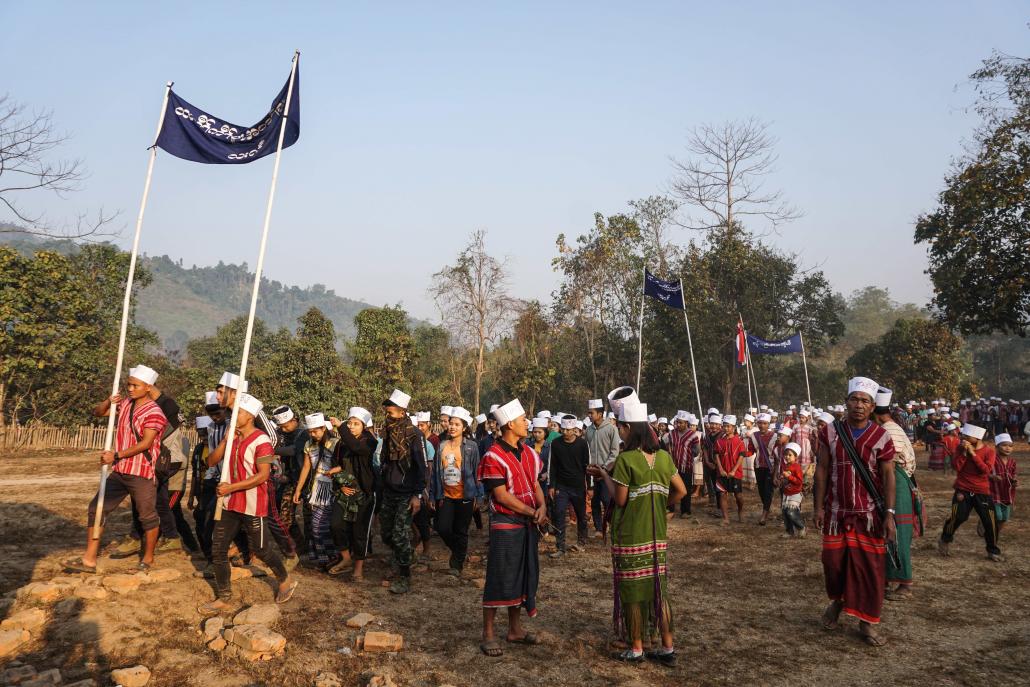
Karen villagers in Day Bu Noh protest Tatmadaw road-building on Karen National Day, February 11. (Vincenzo Berezini | Frontier)
Business and conflict
The fear and deprivation experienced by civilians in Mutraw over the last month – an echo of previous waves of violence and displacement in the area, stretching back decades – shows not only the failure of ceasefire agreements to protect civilians but also the dangers posed by development projects, and schemes aimed at regional connectivity, in the absence of a peace settlement.
The Asian Development Bank, which is co-financing upgrades to a highway running through Kayin that is part of the East-West Economic Corridor linking Myanmar with Vietnam, has referred to the state as a “post-conflict” area in project documents. However, fighting has in fact intensified precisely in the areas in which international financial institutions, private companies and the Tatmadaw have significant business interests or infrastructural plans.
Since the 2012 ceasefire, most armed clashes in Kayin have occurred close to the planned Hat Gyi Dam in southern Mutraw, along the route of the ADB co-sponsored highway, and along the road network described in this article. This fits a national pattern of infrastructure and development projects acting as drivers of conflict, instability and ethnic tension in resource-rich or geopolitically important border areas such as Rakhine, Kachin and northern Shan states.
Myanmar civilian authorities, as well as the Tatmadaw, have said the road-building is in aid of “local development” and has local support. However, in October last year there were community protests against road construction in Muthe and Luthaw, which followed protests earlier in the year.
Previous reports have shed significant doubts on the legitimacy of a letter signed in August 2016 by a local administrator in Muthe and three community members requesting the road’s expansion. A September 2019 article by Al Jazeera said one of the signatories of the Burmese-language letter could not understand Burmese and quoted an anonymous KNU official as saying that the Tatmadaw had presented the letter in discussions with the KNU as proof of local demand, which the KNU dismissed as bogus. Tatmadaw spokesperson Zaw Min Tun told Al Jazeera the road construction was “for the development of the area” and so “shouldn’t be an issue for the peace process”.
A resident of the Day Bu Noh area of Luthaw, who was familiar with the ongoing conflict, said, “If they continue these attacks, there will be zero trust between the [KNU] and the Tatmadaw.”
“How can we trust what the Tatmadaw says when they continue to use these tactics and carry on playing tricks on us?” he said. “They will never talk about stable peace with us. They just play around; to them it is like a game. It will never finish.”
This deterioration of trust could undermine the current negotiations between the government and the KNU, as well as other ethnic armed organisations that have signed the NCA. The goal is to reach an agreement on holding a 21st Century Panglong Union Peace Conference in April or May, before the focus shifts to this year’s general election. As a precondition for participating in the Panglong conference, ethnic armed groups want to clarify key terms in the NCA that are unclear. They argue that this is necessary to avoid further conflict with the Tatmadaw, and want the new NCA definitions to be approved at the conference.
But above clarity in the NCA text is the more fundamental issue of trust. In spite of direct prohibitions in the agreement – not least, on the targeted or indiscriminate shelling of civilian areas and forced displacement – NCA violations continue. For the people of Mutraw, whose lives have been shaped by conflict for over half a century, there are few glimmers of hope that longstanding grievances will be remedied.


